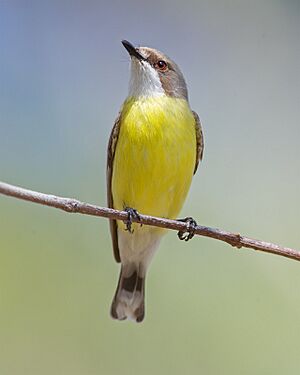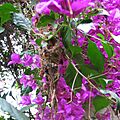White-throated gerygone facts for kids
Quick facts for kids White-throated gerygone |
|
|---|---|
 |
|
| Conservation status | |
| Scientific classification | |
| Genus: |
Gerygone
|
| Species: |
olivacea
|
| Subspecies | |
|
|
The white-throated gerygone (Gerygone olivacea) is a small, active bird. It belongs to a family of birds called Acanthizidae. These birds are sometimes called "Australian warblers." You can find this bird in Australia and Papua New Guinea.
People also know this bird by other names. Some call it the white-throated warbler. Others might call it the white-throated flyeater. It is also known as the bush canary or native canary.
Where They Live
White-throated gerygones like to live in different kinds of forests. They can be found in cool, mild forests. These are called temperate forests. They also live in warm, wet forests. These are known as subtropical or tropical moist lowland forests. These places provide the perfect home for them.
Amazing Nests
White-throated gerygones build very interesting nests. They often choose a strong plant like Bougainvillea. The birds start by winding sticky threads around a stem. These threads often look like spider web. This sticky base helps hold the nest together.
After the sticky foundation is set, they add other materials. They might use strips of bark and small twigs. They also use animal fur and other soft fibres. Building the nest takes several weeks. The birds do not work on it every single day.
As the nest gets heavier, the branch it is on might bend. It can even bend to point straight down. The nest usually has a round opening for the birds to get in. Both the male and female gerygones help build the nest. Sometimes, after all that work, the birds might leave the nest. This could be a trick to fool predators.
Gallery
- Gerygones nesting in ''Bougainvillea'', rural New South Wales garden
-
Fig 1. The bird(s) wound sticky threads around a Bougainvillea stem.
These threads appeared to be spider web. -
Fig 2. The nest was located in among the Bougainvillea foliage.
Both sexes seemed to help build it. -
Fig 5. The nest took several weeks to build.
It was made from strips of bark, twigs,
animal fur, and manufactured fibres.










